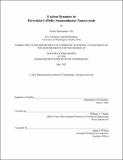Exciton Dynamics in Perovskite CsPbBr₃ Semiconductor Nanocrystals
Author(s)
Shcherbakov-Wu, Wenbi
DownloadThesis PDF (9.752Mb)
Advisor
Tisdale, William A.
Terms of use
Metadata
Show full item recordAbstract
Semiconductor nanocrystals, or quantum dots, have attracted much attention over the past three decades due to their potential applications in optoelectronic devices, such as displays, sensors, photovoltaics, and as single-photon sources. This class of materials differs from traditional bulk semiconductors in their tunability of optical and electronic properties, which are determined by their size as well as the material composition. In the past decade, a new type of semiconductor, perovskite, has shown extraordinary photophysical properties; their low-dimensional counterpart, all-inorganic perovskite nanocrystals (CsPbBr₃ NCs), has since shown promising performances in optoelectronic devices. However, their fundamental photophysical properties, as well as energy transport properties within the NC solids, are still under active debate.
Here, I measure both the temperature-dependent (35 K - 300 K) absorption and PL spectra of zwitterionic ligand-capped CsPbBr₃ NCs with four different edge lengths (L = 4.9 - 13.2 nm). The excitonic transitions observed in the absorption spectra can be explained with an effective mass model considering the quasicubic NC shape and non-parabolicity of the electronic bands. We observe a temperature-dependent Stokes shift; while the trend is similar to the Stokes shift observed in both MAPbBr₃ and CsPbBr₃ single crystals, it does not approach zero at cryogenic temperatures, pointing to an additional contribution intrinsically present in the NCs. Surprisingly, the effective dielectric constant determined from the best fit model parameters is independent of temperature.
Next, I apply time-resolved photoluminescence microscopy (TPLM) to visualize exciton transport in CsPbBr₃ NC films with various surface treatments. We show that, in all samples, exciton diffusivity exhibits a striking excitation power dependence. Through fluence-, repetitionrate-, and temperature-dependent measurements, we demonstrate that this behavior does not arise from exciton-exciton annihilation or sample heating effects. Further investigation reveals that upon photoexcitation, CsPbBr₃ NCs transform into a transient configuration wherein exciton transport becomes faster. This reconfiguration memory persists for microseconds, long after electronic relaxation.
Finally, I present preliminary TPLM measurements on CsPbBr₃ NC superlattices at cryogenic temperatures. We observe interesting power-dependent and temperature-dependent trends. While the exact transport mechanism in this regime is still unclear, the findings point to new transport phenomena that require further investigation.
Date issued
2022-05Department
Massachusetts Institute of Technology. Department of ChemistryPublisher
Massachusetts Institute of Technology